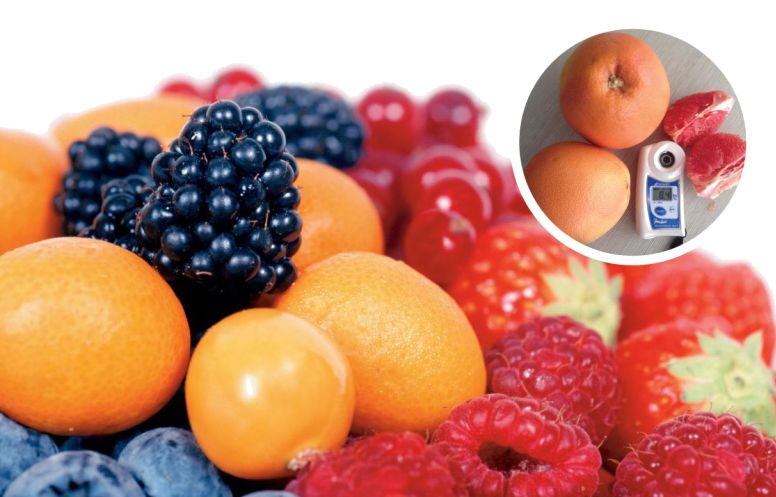
Said to yunnan plateau characteristics of fruit, the first thing we think of the most impressive is more inspirational "chu orange" to the person, because chu orange gives us not only the spiritual incentive, and the fruit quality requirements, with the standard of chu orange fruit tasting a set of system requirements, including the fruit size, fruit surface smoothness, skin thickness, pulp sugar, acidity, VC, edible rate, etc., is a study of fruit industry.
Fruit quality stand or fall not everyone can be defined, its quality is good or bad to a certain quantitative basis, fruit quality is divided into two aspects of sensory properties and biochemical properties and sensory properties by the people through sight, smell, touch, taste, give a person a kind of knowledge, including the appearance quality of the fruit size (longitudinal x horizontal stem), skin thickness, shape, color, surface defects (such as wind damage, wear, rusty spot), and acid, sweet, bitter, astringent, chewing feeling when the fruit hardness, tender flesh, edible rate and melting rate, etc. Biochemical properties refer to the amount of nutrients and health functional substances contained in fruit, including fruit pigment, VC, amino acids and minerals.
Yunnan is characterized by the development of agriculture in the plateau, with a wide variety of fruits. Usually, the sugar, acidity and sugar-acid ratio of the fruits in the fruit tasting are the most common analysis indexes, and also one of the factors that can best measure the taste of fruits. In order to facilitate the farmers to understand the fruit quality, yunnan youke lvdu agricultural research institute specially launched several kinds of high-precision, portable and affordable sugar acidity detection instruments for different fruits (Japan aituo, made in the original place).

Meaning of test value:
Brix% (sugar content) : represents the weight and percentage of sucrose in 100g sucrose solution. It measures the total soluble solids in the solution, namely the total sugar concentration.
Acid: the total Acid in the sample is tested according to the principle of conductivity and converted into citric Acid (citrus), tartaric Acid (grape) and malic Acid (apple) concentration.
1. Measurement of sugar acidity of citrus fruits


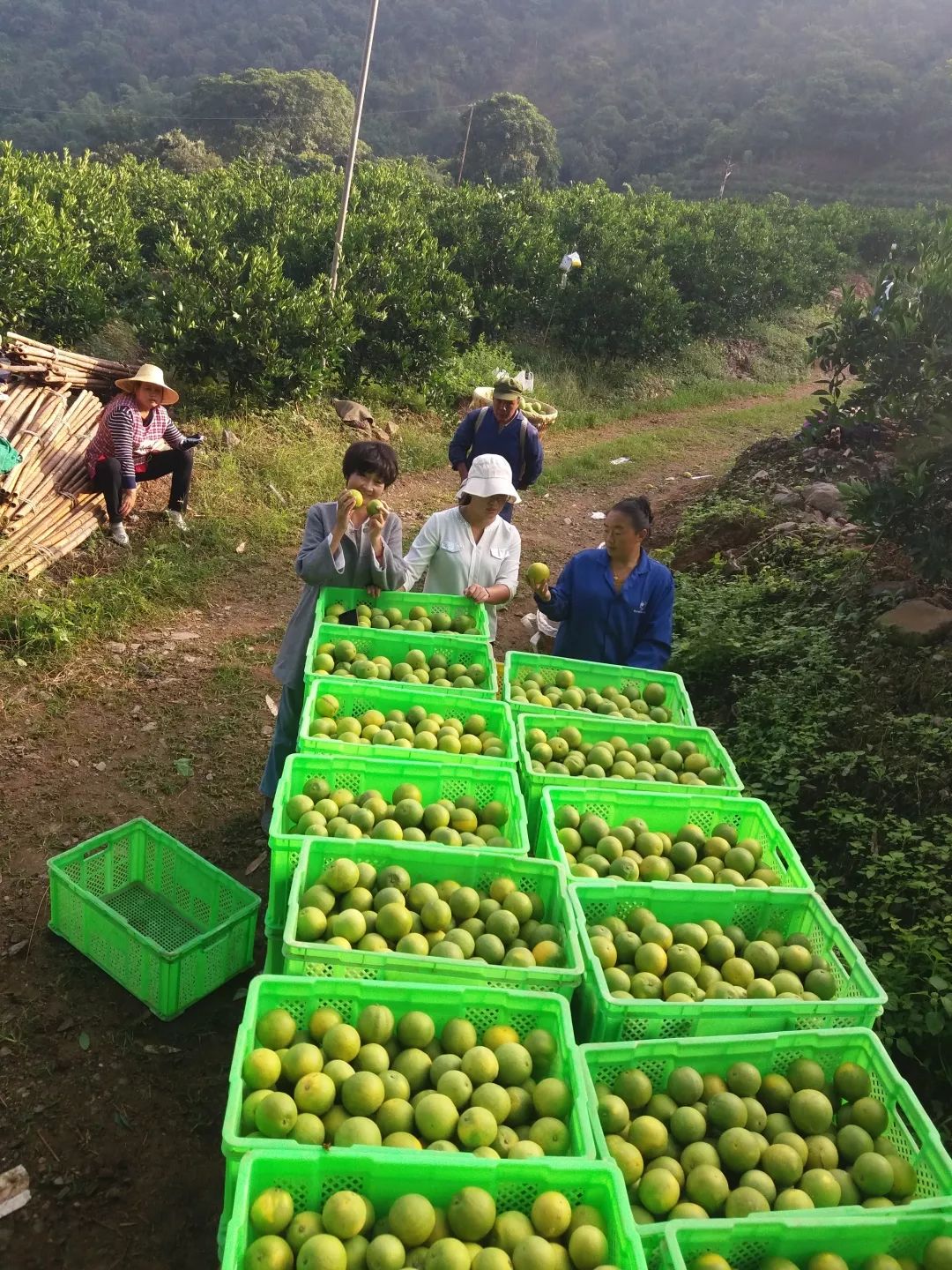
The measured values of different tree ages of customers in a base planting iced tangerine orange in the turning period are as follows:
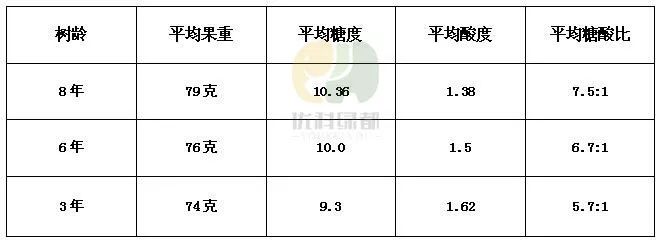
The change trend chart is as follows:

Through the measurement of sugar and acid all-in-one machine, the sugar, acidity and sugar and acid ratio of fruits of different ages in the turning stage are different. Therefore, we can make preparations in advance according to the measurement data and select timely harvest to make the fruit taste the best when it reaches the hands of consumers.
2. Measurement of sugar acidity of tomato fruits
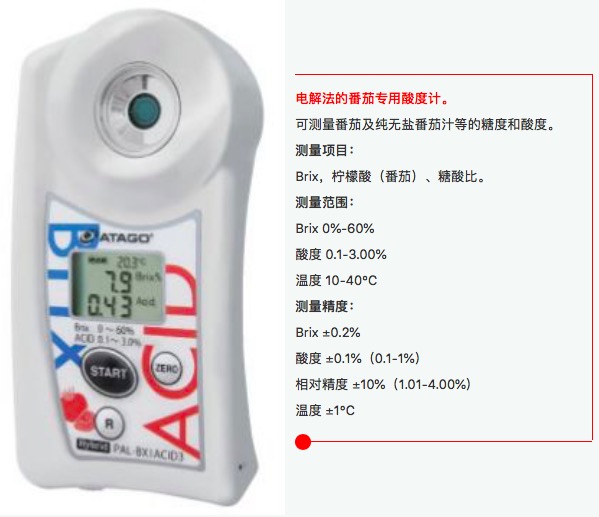
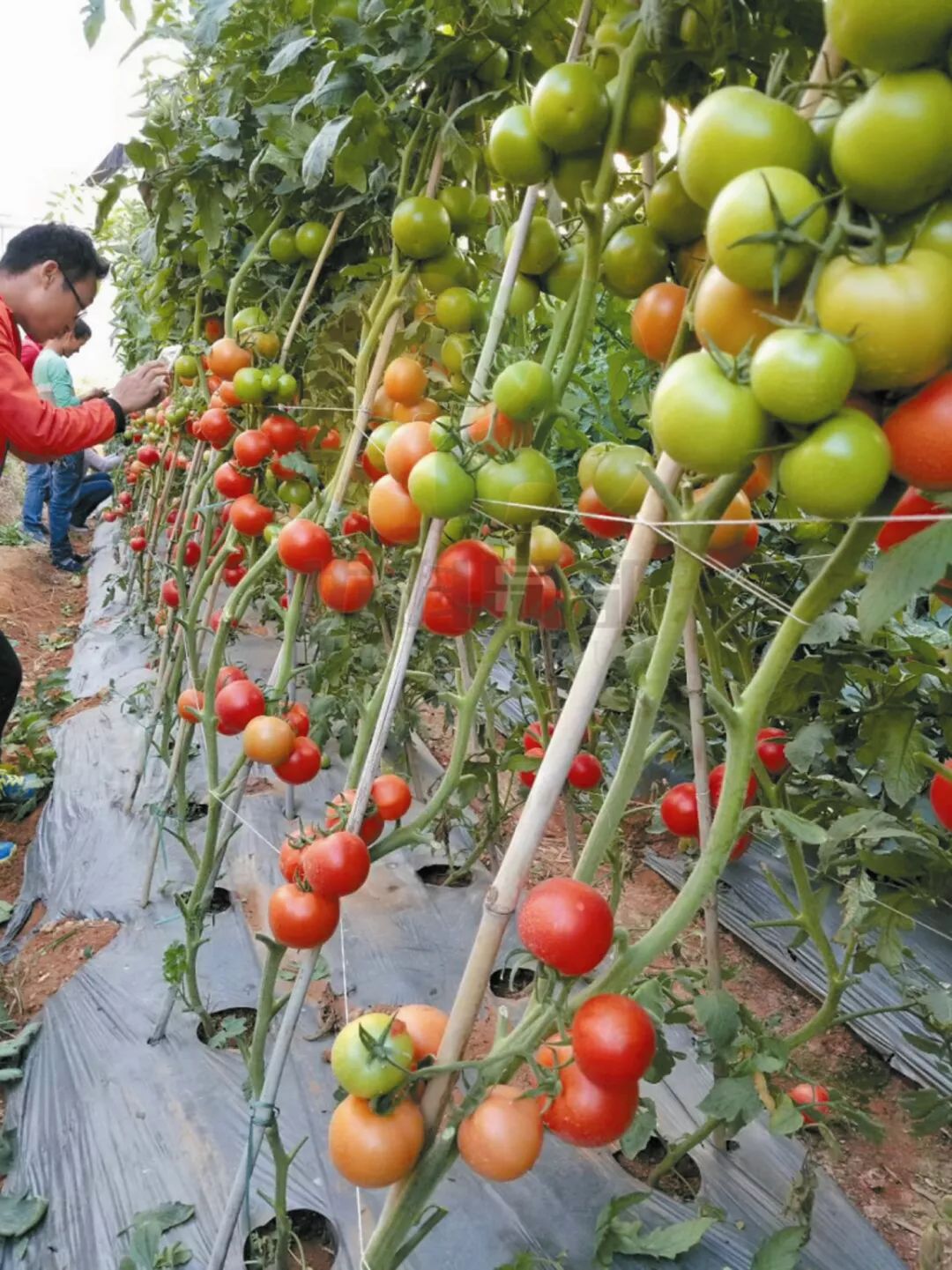
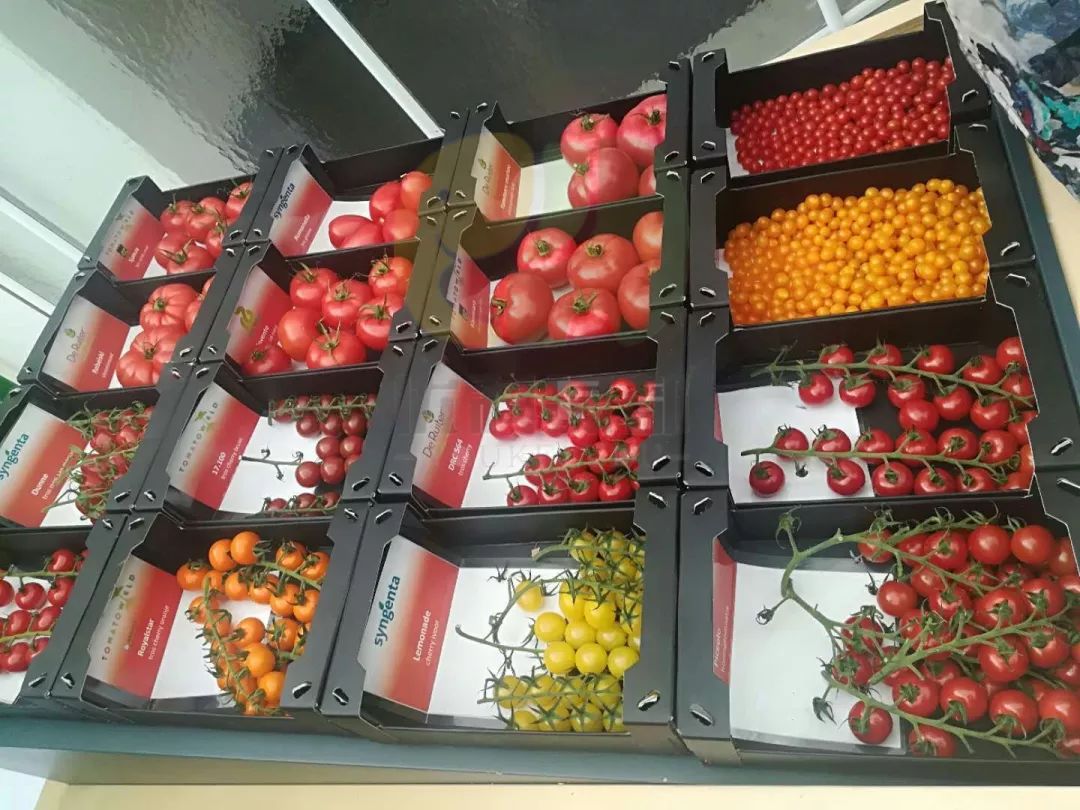
3. Measurement of sugar acidity of grape fruits
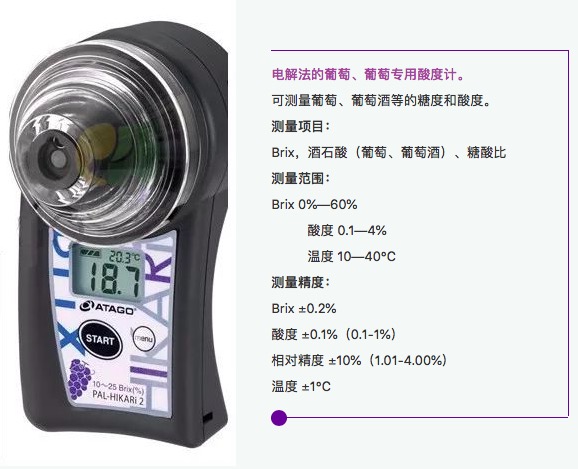
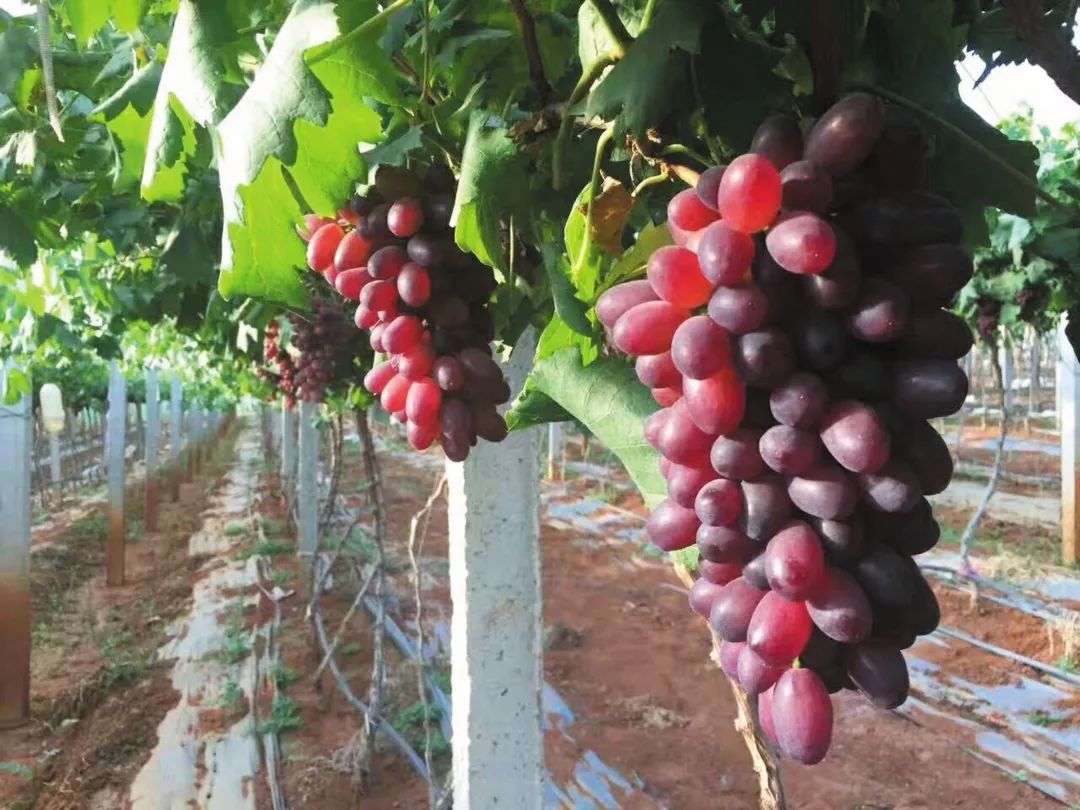

The sun rose Different sugar and acid ratios, different valences.
4. Measurement of sugar acidity of apple fruits
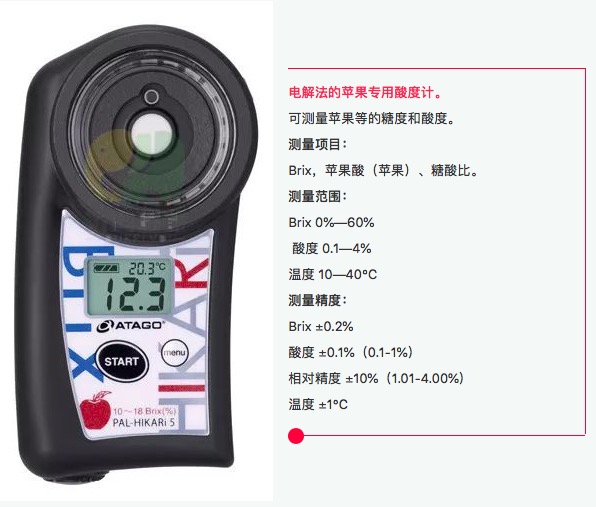



5. Acidity measurement of strawberry sugar
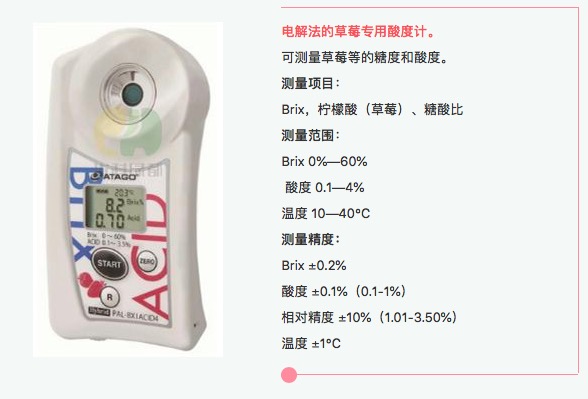
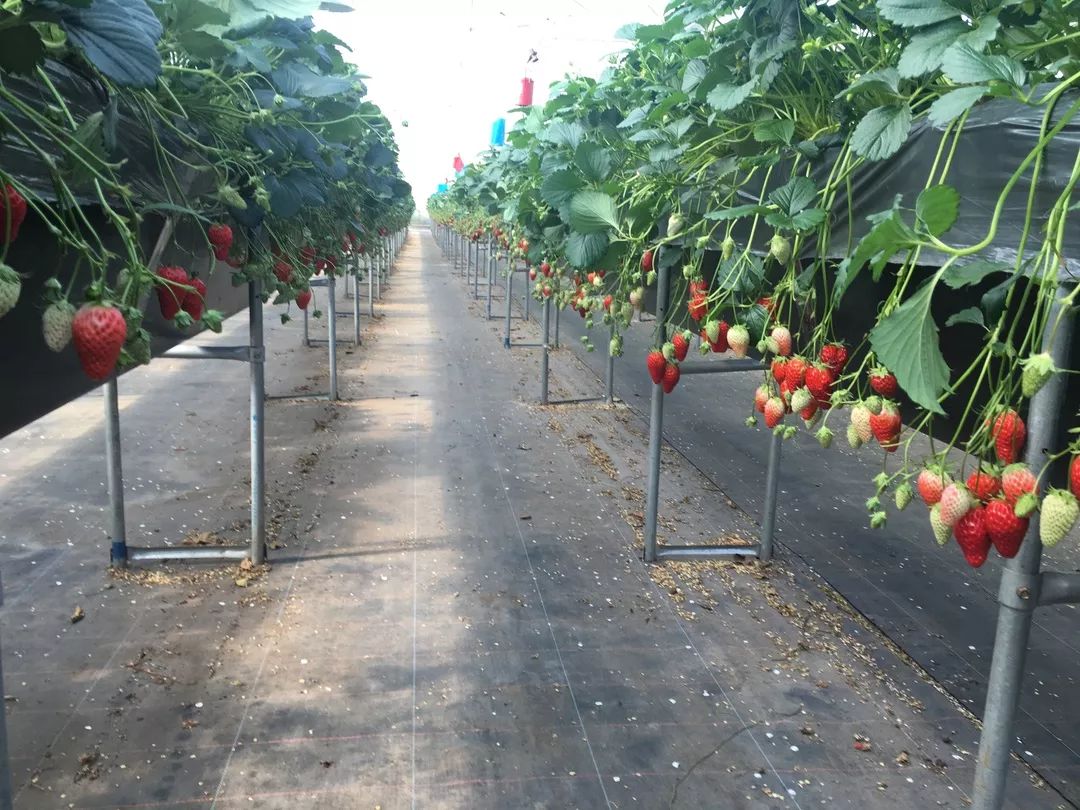

6. Polyfructosic acid all-in-one machine measurement

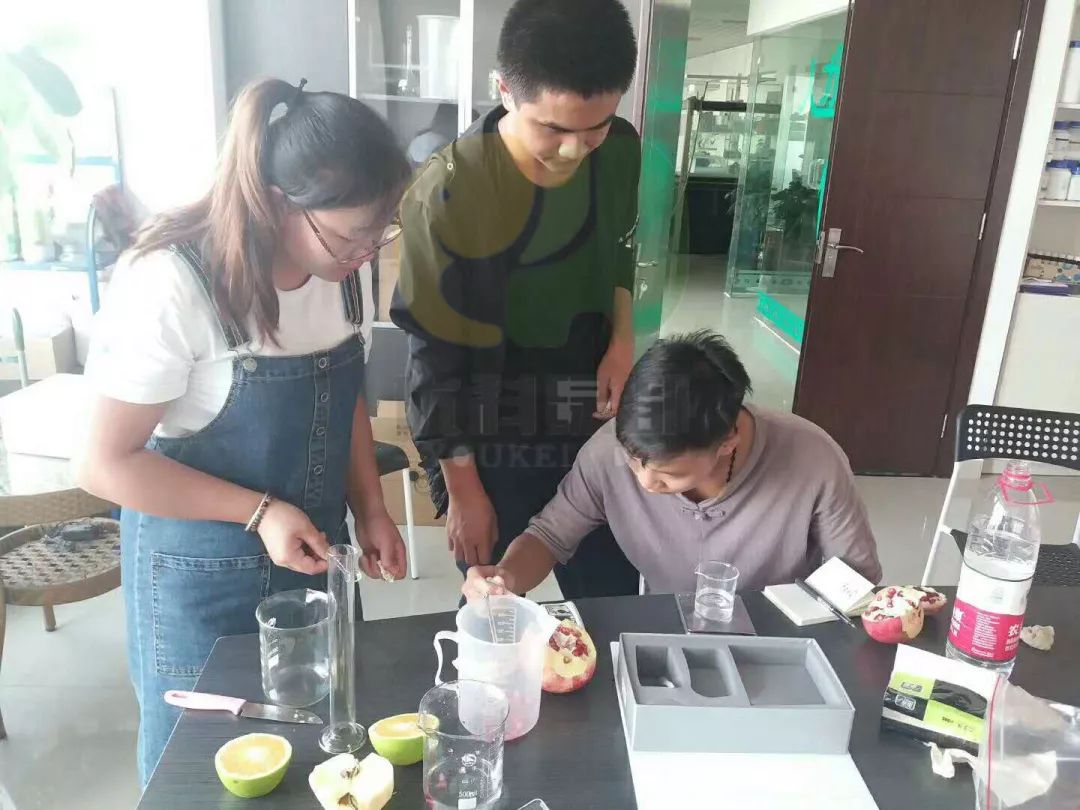

7. Comparison between multiple fruit measurement and single fruit measurement.


By measuring the result analysis shows that special all-in-one and citrus fruit acid as measured on the same citrus fruit sugar acid machine there are some differences in measurement data, but we can see from the picture the measurement standard error of plus or minus, i.e. according to the statistics of "the principle of minimum probability event no possibility", its error is negligible, so the measurement result is accurate. In actual fruit measurement, the most important thing we should do is to find out the change law of fruit sugar and acidity, and then give reasonable nutrition scheme and farming operation.
The sugar and acid all-in-one machine is used more and more in the fruit tasting, which indicates the development of China's fruit industry is becoming more and more standardized, the fruit we eat will be more nutritious, more healthy, more assured!
When it comes to citrus, most of us are left with the impression that we've swallowed something whole, tasted a little of it, and sometimes just for the simple purpose of filling or relaxing! When you think about it, the person who savors it will pay attention to its appearance and internal taste. This is what we call fruit quality. Fruit quality is divided into two aspects of sensory properties and biochemical properties and sensory properties by the people through sight, smell, touch, taste, give a person a kind of knowledge, including the appearance quality of the fruit size (longitudinal diameter x transverse diameter), skin thickness, shape, color, surface defects (such as wind damage, wear, rusty spot), and acid, sweet, bitter, astringent, chewing feeling when the fruit hardness, tender flesh, edible rate and melting rate, etc. Biochemical properties refer to the amount of nutrients and health functional substances contained in fruit, including fruit pigment, VC, amino acids and minerals.
People fruit symbolizes the harvest, the more influence factors in the process of production quality, including genetic factors (hybrid parent), external environmental conditions (climate, altitude, soil, etc.), cultivation management measures (irrigation, sewage sludge, pruning, collecting, stock, etc.), and the fruit packaging and transportation, this fruit is a complex system of agricultural engineering.
Through this paper, citrus fruit appreciation, combined with the actual planting management, farming operations and other analysis of fruit factors and regulatory mechanism.
Key words: citrus, fruit appreciation, action mechanism, influencing factors.
1. Citrus fruit appreciation index and its action mechanism.
Usually, we measure the fruit quality is judged by its taste, whether it is the farmer's market, hawkers, fruit shop to buy, usually have a taste of the sample, but not all the taste of people are consistent, different people have different preferences, some people like the meta-acid, some people like a sweet, even if the same fruit different people have different taste sensitivity. Therefore, to judge the quality of fruits, we should establish a quantifiable standard system of fruit appreciation. The following are the indicators and mechanism of fruit appreciation:
1. Sensory appreciation index
Appearance: fruit size (longitudinal diameter transverse diameter), smoothness of fruit surface (oil package size), fruit color.
Longitudinal diameter measuring
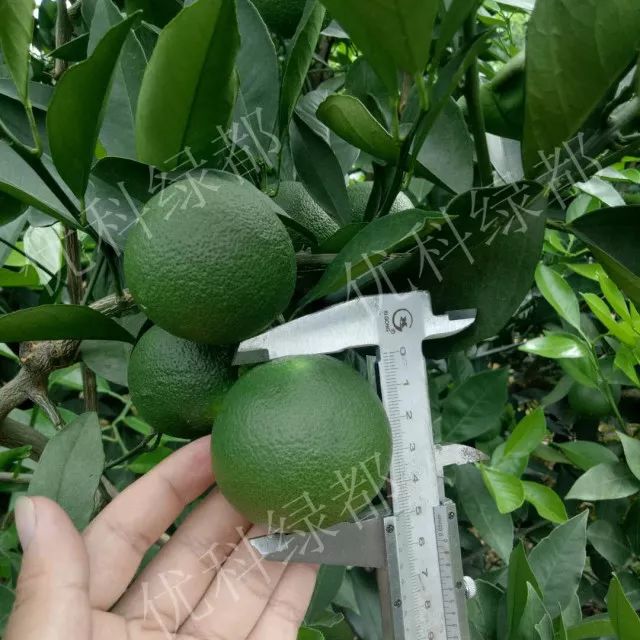

Transverse diameter measuring Orange red, oil cell smooth.
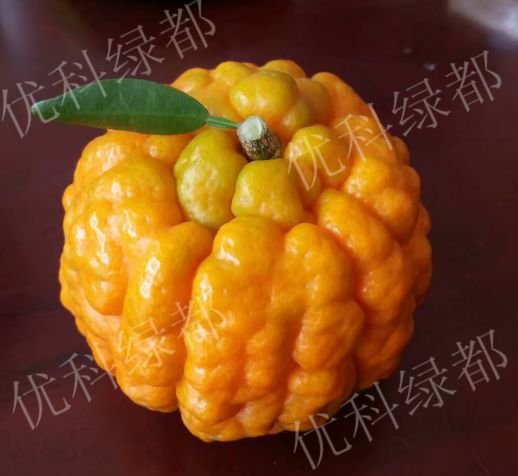
Orange yellow, oil cell is bulky.
Edible rate: the percentage of edible part and total.
(3) slag rate: after the entrance of the slag part and the percentage of edible part.
(4) soluble solid (sugar): mainly refers to the soluble sugar, including monosaccharide, disaccharide, polysaccharide (in addition to starch, cellulose, chitin, hemicellulose insoluble in water), commonly have glucose, fructose, maltose and sucrose, determination of soluble solid can measure the fruit maturity, in order to determine the time to pick.
(5) total sugar (glucose meter/sucrose) : namely the total soluble solids and total sugar of common refers to reducing glucose, fructose, pentose, lactose and under the condition of determination can be hydrolyzed to the reducing of monosaccharide sugar (hydrolyzed to glucose + 1 molecules fructose 1), malt sugar (glucose) hydrolysis of 2 molecules and may be partially hydrolyzed starch (glucose) hydrolysis of 2 molecules, in some sugar meter for total sugar contains soluble solids (such as glucose meter).
Total acid (citric acid meter) : the fruit contains a variety of organic acids, total acidity determination results are usually the most content of the kind of organic acid samples to calculate the results. The main organic acid composition of different fruits is different, and their conversion coefficient is also different, such as malic acid, the conversion coefficient is K=0.067, the main fruit is apple, pear, peach, apricot, plum, tomato, lettuce; Tartaric acid, the conversion coefficient is K=0.075, and the main fruit is grape; Citric acid, the reduction coefficient is K=0.070, and the fruit is citrus; The total acid of citrus fruits should be measured by citric acid titration. The formula for calculating the total acidity measured by laboratory fruit titration is as follows:

Where: concentration of c-standard NaOH solution, mol/L;
V- titration consumption standard NaOH solution volume, mL;
M - sample mass or volume, g or mL;
V0- total volume of sample diluent, mL;
V1- volume of sample liquid absorbed during titration, mL;
K minus the conversion factor, which is 1 mmol of NaOH is equal to the number of grams of the main acid.
The detection report of citrus fruits in a base entering the turning stage is shown as the following figure:

The results were compared as follows:
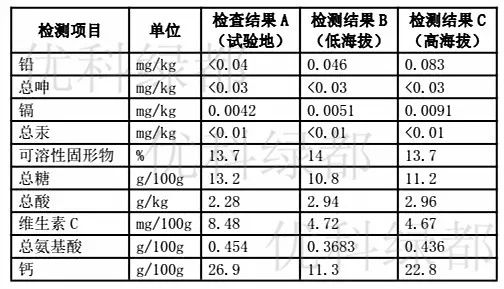
The trend is as follows:
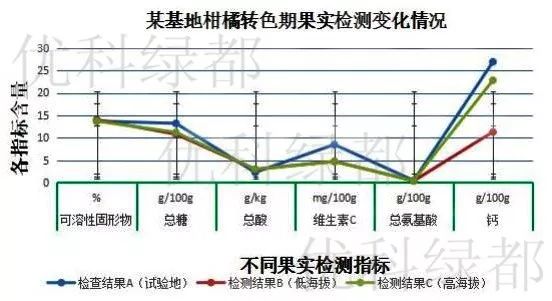
It can be seen from the figure that each index of fruit quality in the test plot (whole-process integration of water and fertilizer) is relatively better than that in the control group (low altitude and high altitude), especially the content of total sugar, vitamin C and total amino acid is obvious.
The test of a certain sugar and acid all-in-one machine is as follows:


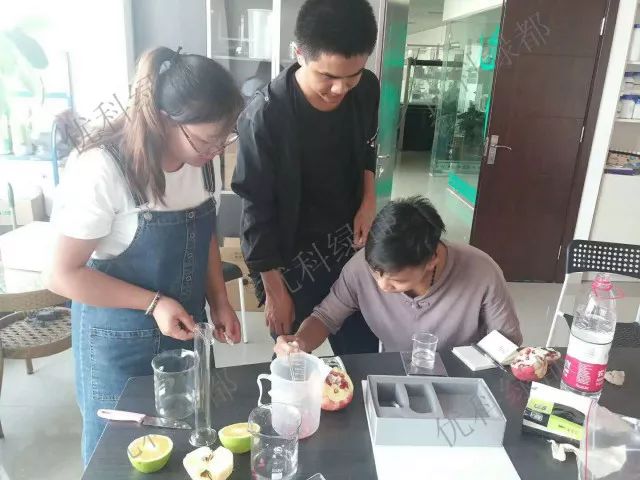
Meaning of test value:
Brix% (sugar content) : represents the weight and percentage of sucrose in 100g sucrose solution. It measures the total soluble solids in the solution, namely the total sugar concentration.
Acid: the total Acid in the sample is tested according to the principle of conductivity and converted into citric Acid (citrus), tartaric Acid (grape) and malic Acid (apple) concentration.
1.1.1 mechanism of action of citrus fruit sugar and organic acids.
Citrus fruit sugar (sugar content) and organic acid (acidity) are important indicators for fruit quality and flavor judgment, and important basis for determining fruit classification, maturity, taste evaluation and commodity price, etc. Therefore, it is extremely important to understand the mechanism of the formation or accumulation of citrus fruit sugar and organic acid.
Citrus fruit sugar is mainly composed of leaf (source) leaves photosynthesis in leaves after the synthesis of assimilation product transportation to reach the fruit, fruit juice, the accumulation of soluble sugar in the cell is the vast majority of sucrose, glucose and fructose, and these three different sugar taste sweetness, the highest fructose sweetness, 1.73 times that of sucrose, 2.7 times that of glucose (sweetness: fructose > sucrose > glucose), scale for different kinds of sugar and fruit sweetness and flavor. The main form of citrus sugar transport is sucrose, which is synthesized in the cytoplasm, then entered the cytoplasm and stored in the vacuole. In general, the accumulation of sugar in fruits began at the stage of fruit expansion and mainly accumulated soluble sugar at maturity. In different citrus varieties, the accumulation of soluble sugar in the cytoplasm is different when the fruit is ripe. For example, the accumulation of sucrose is dominant in wide-skinned citrus, while the accumulation of hexoses (glucose + fructose) is dominant in sweet lime and summer orange.
The content of acid in citrus fruit has an important influence on the flavor, storage, transportation resistance and market acceptability of the fruit. According to the content of titrable acid, it can be divided into high-acid varieties (>1.5%), medium-acid varieties (0.5% -- 1.5%) and low-acid varieties (<0.5%). The source of organic acid accumulation in citrus fruits was different from that of sugar. At the mature stage, citric acid was the main organic acid in most citrus fruits, followed by malic acid and quinic acid, such as oranges (navel oranges, ponkan oranges, willow oranges, newhall navel oranges, etc.) and broad-skinned oranges (wenzhou mikan, ponkan, wo mandarin, huo mo huo, mercotte, aiyuan 38, granulated tangerine, etc.). Low-acid or acid-free juices are dominated by malic acid, such as sweet lemon and dark sweet orange.
1.2 biochemical evaluation indexes:
Fruit pigment: the color of citrus flowers and fruits is mainly determined by water-soluble pigment (flavonoids, beet pigment) and fat-soluble pigment (carotenoids, chlorophyll) :

Amino acids: fruit contains essential amino acids, semi-essential amino acids and non-essential amino acids, such as threonine, lysine, valine, phenylalanine, histidine, glutamate and so on.
VC: vitamin C, also known as l-ascorbic acid, is a water-soluble vitamin, lack of it can cause scurvy.
1.2.1 mechanism of action of major pigments in citrus fruits
When the citrus fruit is immature, it accumulates a lot of chlorophyll. The color of carotenoids is covered by chlorophyll, making the peel dark green and the flesh light green. After fruit is mature, chlorophyll is degraded, basically contain kind of flavonoid and carotenoid, make pericarp mostly show yellow, orange yellow or orange red, flesh shows orange yellow, flaxen or orange red. In most citrus skins and pulp, its orange yellow, orange red, pink or red is mainly caused by the large accumulation of carotenoids, while blood orange is the only orange strain mainly colored by anthocyanin.
Carotenoids can be synthesized and accumulated in green and non-green parts of plants. The carotenoids in carotenoids contain no oxygen atoms, and the molecular formula is C40H56. Xanthophyll contains two oxygen atoms, and the molecular formula is C40H56O2. Flavonoids are synthesized in the cytoplasm of plant cells through a series of enzymatic hydrolysis reactions on the main chain (chalcone synthase, chalcone isomerase, flavanone 3-hydroxylase, flavanone 4-reductase, etc.) to further form anthocyanin and anthocyanin. Anthocyanin or anthocyanin is the derivative of 2-phenylbenzobenzopyrane (), while anthocyanin is the sugar, acyl or methyl substituent of anthocyanin. The right phenyl ring hydroxyl substitution of anthocyanin is different, and anthocyanin can be divided into geranium pigment (brick red), centaurea pigment (purple red) and delphinidin.
2. Analysis of influencing factors of fruit quality
There are many factors affecting the quality of citrus fruits, such as variety characteristics (innate genetic factors), external factors (acquired growth environment), external factors such as growth environment, fertilizer and water management, farming operation, and post-harvest packaging and transportation, etc. To understand the factors affecting the quality of citrus fruits and to control them in time can ensure the best taste and flavor of citrus fruits when they are ripe, that is, to ensure the reasonable ratio of sugar and acid, the rate of slag melting, peeling and so on.
2.1 environmental factors
In the process of citrus growth, environmental factors should be the primary consideration, because the growing environment is mostly objective and uncontrollable. For example, local climate problems include altitude (latitude and longitude), annual rainfall, air temperature and humidity, duration of sunshine, temperature difference between day and night, soil type, light quality and so on.
Such as the influence of illumination on the accumulation of sugar in the bagged fruit mature period, the same trees, different parts of fruit by light intensity, general illumination intensity is abate, in turn in the canopy on the part of peripheral lighting quantity than cella light quantity is big, so outside the upper fruit and fruit are more mature than before, in order to guarantee with the number of fruit taste homogeneity, general batch picking first pick when the upper and the periphery of the fruit.
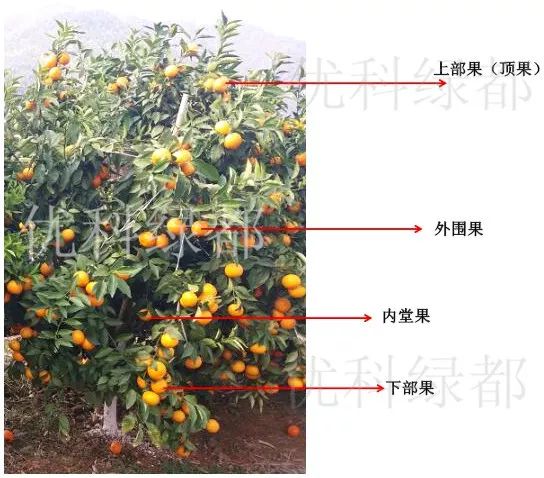
2.2 cultivation and management measures
(1) stock selection: general citrus stock selection has orange, orange, orange, orange, etc., different culture environment should choose different stocks for grafting. For example, if the water level in guangxi is high and the humidity is high, the fruit of aurantii is generally selected as the rootstock. In the characteristic areas of yunnan plateau, especially in mountainous areas with high winds and low water level, the anvil of orange is generally selected for grafting. Of course, other factors should be considered in the selection of grafting rootstock, such as the resistance to diseases and affinity of rootstock.

Product shell root stock
(2) fertilizer and water management: fertilizer and water management is the fruit sugar, organic acid, minerals, VC and amino acid accumulation of important factors, reasonable fertilizer formula, fertilization is the key to the normal supply of fruit nutrition.
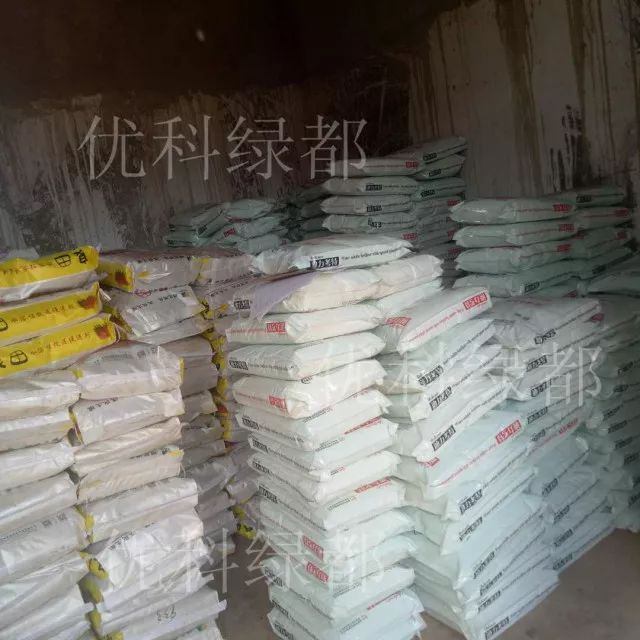
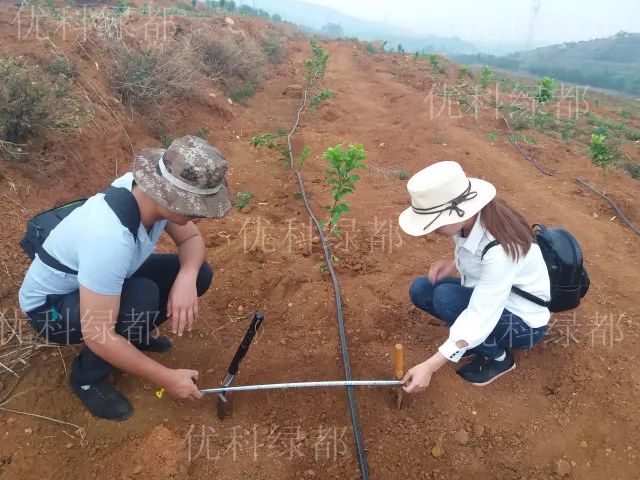
Soil penetration range measurement
(vertical penetration + horizontal penetration + deep penetration)
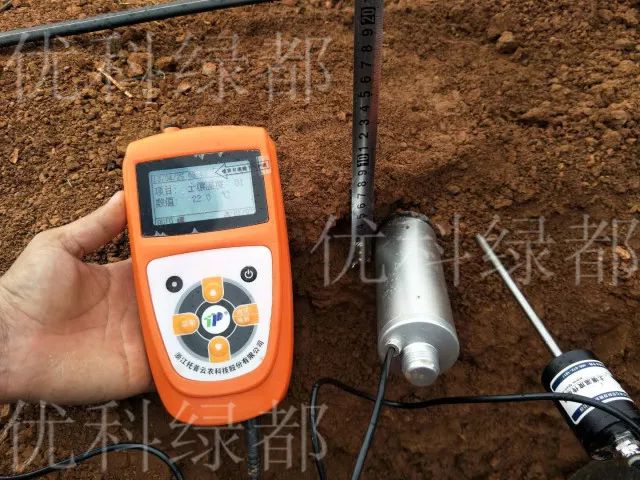
Soil temperature and humidity measurement
Through field measurement, the fertilization time and frequency can be accurately grasped, so that the fertilizer can quickly penetrate into the main distribution layer of root system through mass flow and diffusion, so as to ensure the efficient supply of water and nutrients to crops.
(3) trim
Personally, I think pruning is one of the most important farming operations in planting management, because the quality of pruning means the number of hanging fruit in the coming year (reasonable ratio of leaf to fruit), the location of hanging fruit, light and air permeability, fruit nutrition supply and so on.
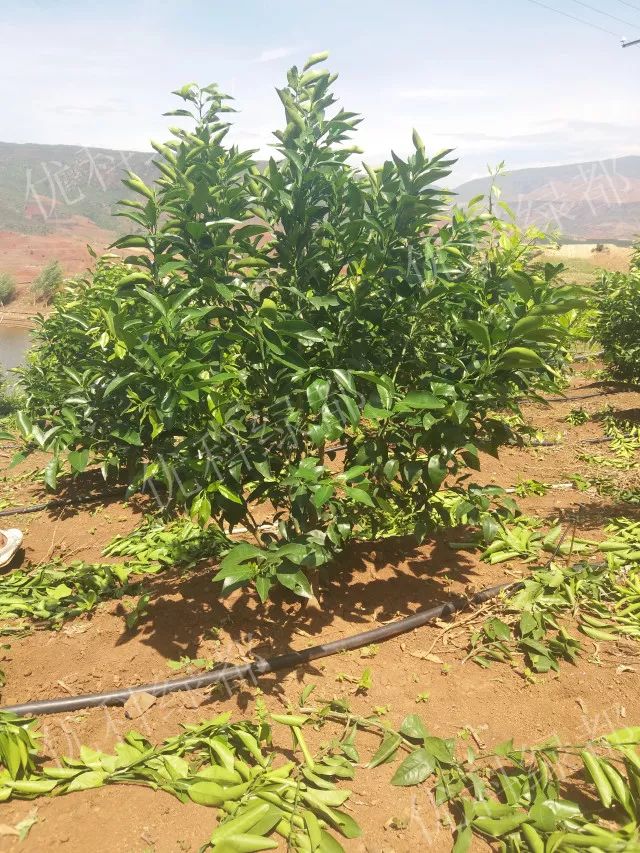
Usual clip method has put tip of wipe bud, pick the heart, short cut, dredge cut, retractive cut. According to the orange tree is different, different growth period, the pruning way, combined with twenty-four seasonal (weather conditions) arrange clip, do reasonable Ye Guo than (walter spinosa plain 50:1 fruit, sweet orange plain 40:1 fruit), branches strewn at random have send, ventilation and pervious to light, avoid too much sun, unified put tip, mother GuaGuo branches and GuaGuo parts scheduled for next year.
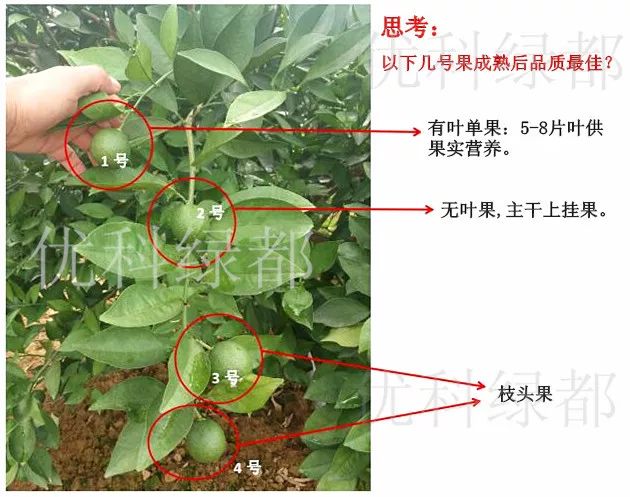

2.3 harvest and preservation
From the planting terminal to the consumer's mouth, time difference and preservation measures can also lead to fruit quality deterioration. Fruits have self-ripening function in the process of transportation, so the picking side must be well controlled, and the proper picking period (maturity) and preservation measures (cold chain logistics, cling film, buffer plastic, etc.) should be selected to ensure the best fruit quality in the hands of different consumer groups.
With the development of agricultural modernization, fruits and vegetables and various horticultural cultivation are moving towards the direction of intensification and scale. These technologies have greatly improved the production efficiency, at the same time, guaranteed the stability of agricultural production and greatly improved the economic benefits. However, in the closed greenhouse, some special links also worry a large number of growers. For example, in the key planting link of crop pollination, the lack of wind pollination, insect pollination and bird pollination in the original nature has greatly restricted the production.
At present, farmers generally use artificial pollination to consume a large amount of labor. In order to promote the development of fruits, growth regulation hormones are often added during artificial pollination. Uneven pollination will increase the incidence of malformed fruits. At the same time, because of the improper use of growth regulators, crop growth or premature aging and other stunted growth problems. The use of chemicals without safety assessment will eventually lead consumers into a health and safety hazard.
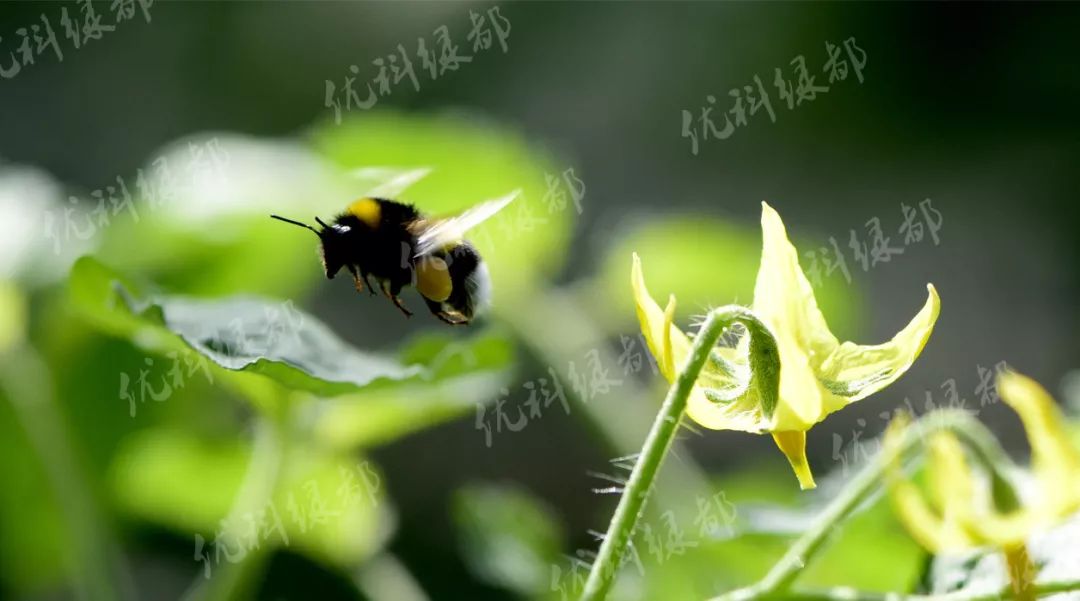
High fruit setting rate is very important for crop production, and pollination is the key step of fruit setting. Bee pollination has long been considered the best way to pollinate crops in the field. Since the late 1980s, however, bumblebees have generally proved far more effective pollinators than bees in most environments. At present, the bumblebee is widely used in protected area with open pollination of crops, greenhouse vegetables and fruit trees pollination, it can not only improve crop yield, more important is can improve fruit quality, reduce the rate of deformity fruit, solve the problem such as hormone pollution brought by the applied chemistry pollination, therefore, bumblebee become the ideal of greenhouse vegetables pollination insects, using bumblebees pollination also to become the world recognized green food production is an important measure.
What are the characteristics of bumblebees?
1. Annual breeding: the diapause period of the queen bee can be shortened or broken under artificial control conditions, and the bumblebee pollination group can be bred according to the pollination needs of greenhouse vegetables in any season, thus solving the problem of applying insect pollination to greenhouse vegetables in winter.
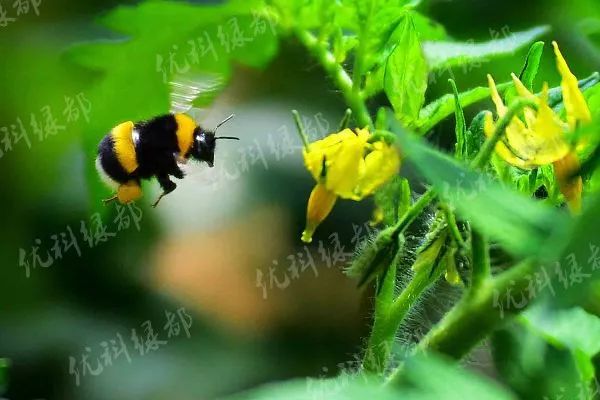
2. Bumblebee has a long mouth organ (kiss): its kiss is 9-17 mm long, so for some vegetables with deep crown flowers, such as tomatoes, peppers, eggplants, etc., bumblebee pollination effect is more significant.
3. Strong collection force: bumblebees have large individuals, long life span, and are covered with fluff all over the body. They can fly over 5 kilometers and make more efficient use of the dense powder source than other bees.
4. Low temperature and low light tolerance: bumblebees can still collect pollination outside the nest in low temperature and low light environment. The annual pollination of greenhouse crops, especially in winter, can be realized by utilizing the biological characteristics of bumblebee in low temperature tolerance.
Poor phototaxis: in a greenhouse, bumblebees don't fly up into the glass like bees do, but rather meekly collect flowers.
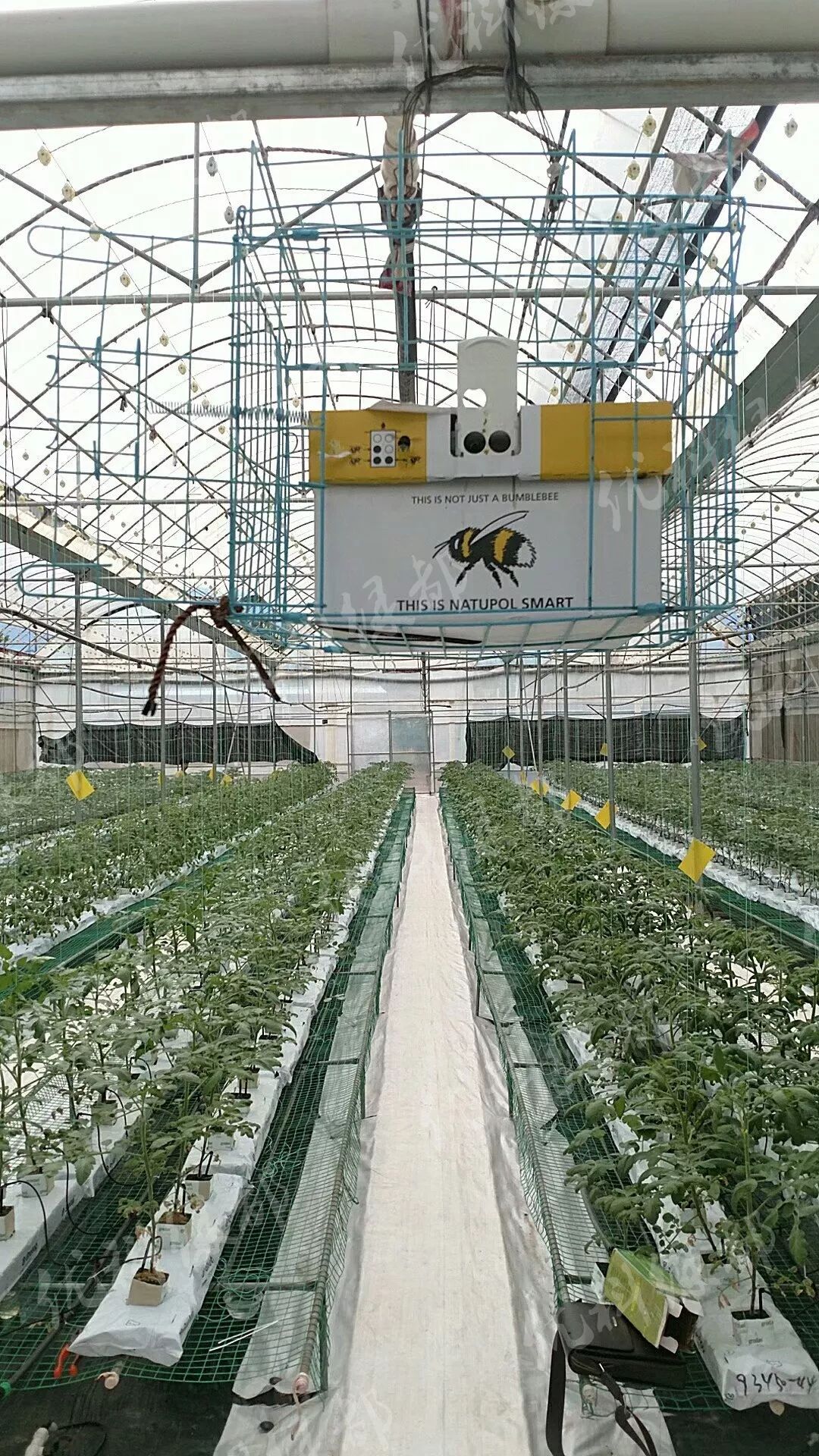
6. Strong moisture resistance: bumblebees are relatively adaptable in the greenhouse with high humidity.
Loud: the flowers of some plants release pollen only when they are vibrated by the buzz of insects, making bumblebees ideal pollinators for such crops as strawberries, tomatoes, and eggplants.
2. Advantages of bumblebee pollination:
1. Significant yield increase: pollination of greenhouse tomato, green pepper, eggplant, strawberry and other vegetables, yield increase effect of more than 30%.
2. Improve quality: bumblebee has strong pollination power and high pollination rate. After pollination, the individual size of the fruit is uniform and the shape of the fruit is good and there is no abnormal fruit.
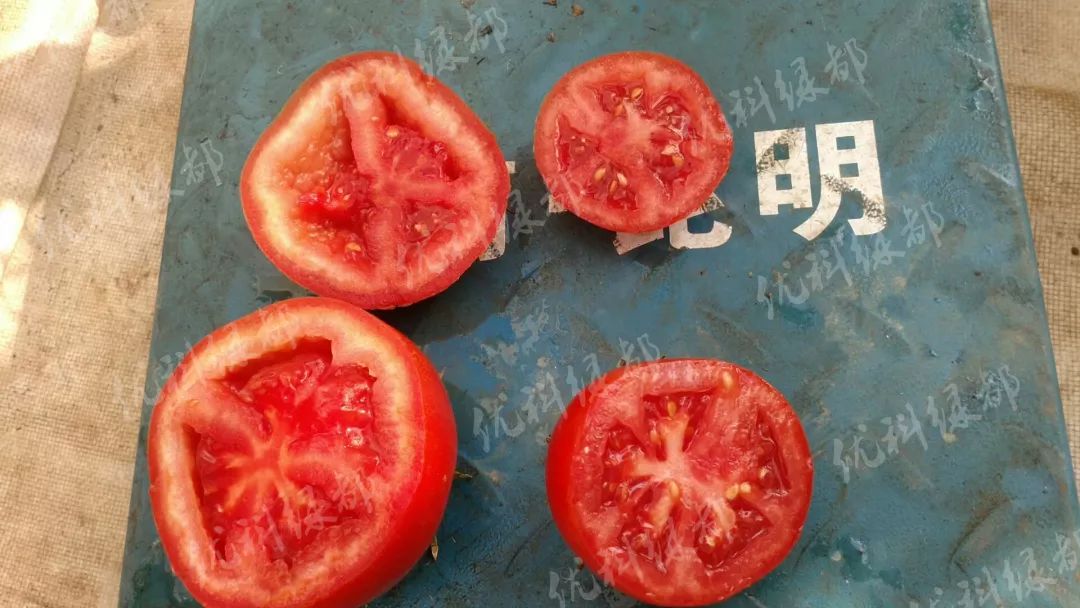
Left: hormone spots - seedless, hollow, less juice, fibrous flesh margin
Right: bear peak pollination - moderate fruit type, full seeds and flesh, juice
3. Time-saving and labor saving: the pollination work is completed by bumblebees without any labor. Can complete the crop pollination work in time effectively, enhances the pollination efficiency.
4. Improve the ecological and environmental benefits: the use of bumblebee pollination will reduce the use of toxic pesticides, and increase the use of low-toxicity, high-efficiency and safe pesticides, and consciously emphasize the use of biological control technology; Bumblebee pollination replaces hormone pollination, reduces the pollution caused by hormone, improves the quality of fruits and vegetables, protects the ecological environment, and is beneficial to the health of consumers.
Three, how to place the hive:
1. Beehives should be placed where bumblebees and humans can easily see them.
2. Do not shake the hive during transportation, and make sure the hive is placed horizontally. Wait about 20 minutes for the bumblebee to calm down before opening the hive.
3. Beehives should be placed 0.5-1 meter away from the ground to avoid direct sunlight and rain. In winter, take care that the hive inlet and outlet are not blocked by crop leaves.
4. Keep the hive away from the co2 supply and prevent ants from entering the hive.
5. When the bumblebee flies for the first time, it must make sure that the ventilation Windows of the greenhouse are closed before opening the exit of the hive. Avoid bumblebees from flying out of the greenhouse during directional flight.

Iv. The best time for bumblebee pollination
After the first directional flight, bumblebees will begin pollinating crops immediately. Bumblebees are generally active in the morning and afternoon. Activity also depends on the flowering of the crop. Bumblebees in 8-28 ℃ temperature is active, but the highest efficiency in the 15 to 23 ℃.
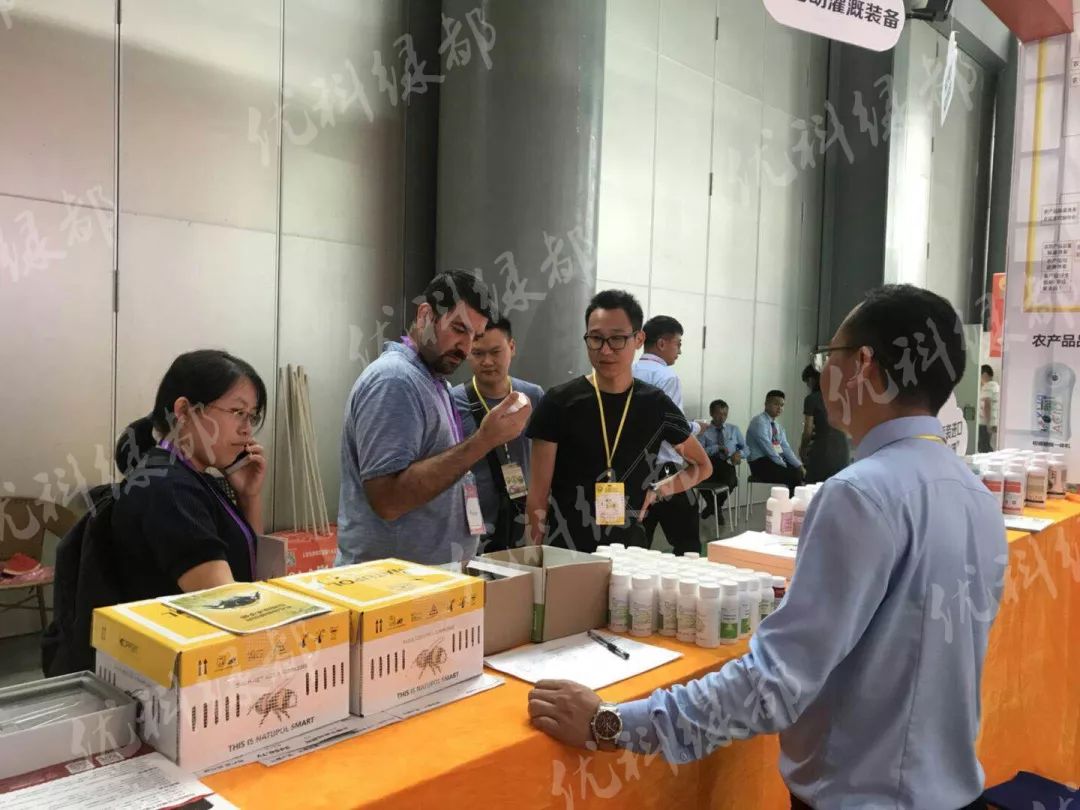

5. Reasons for choosing colbert bumblebee:
KOPPERT B.V. is a world leader in crop pest control and bio-pollination. Colbert is known for reliability, innovation and quality. So with that out of the way, I think you're starting to get a sense of the colbert bumblebee, and you're starting to get an interest in pollination. With regard to colbert bumblebee, yunnan ucr research institute and colbert Netherlands have entered into a strategic partnership to provide high-quality bumblebees and professional technical services to yunnan growers, so as to maximize the pollination potential of bumblebees and create the maximum value for our customers.
What is biological control?
From the perspective of application, it can be defined as "using natural enemies to reduce the harm caused by harmful organisms to an acceptable level". From the perspective of science, it can be defined as "a kind of natural ecological capacity, that is, the function of regulating the number of hostile plants and animals". Biological control is a science that studies the theory and practice of using natural enemies to control plant diseases, insect pests and weeds in fields. It is also called the management science of parasites, predators, pathogenic microorganisms and herbivorous species that eat weeds.
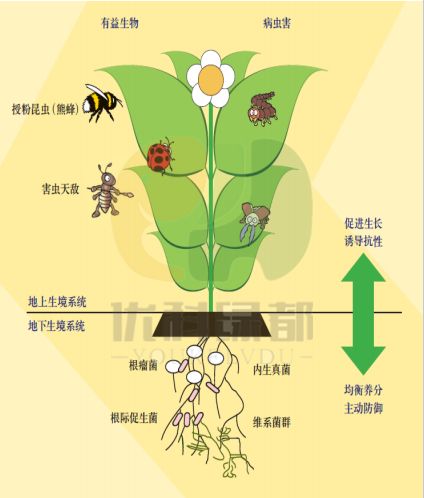
How can biological control improve plant growth
1. Improve the underground growth environment
The beneficial bacteria feed was put into the soil to stimulate the reproduction of the beneficial bacteria community. Beneficial inoculants were directly injected to protect the environment around the root system. Seed treatment, from early life to gain a growth advantage.
2. Improve the aboveground growth environment
The application of biostimulant hormone can promote the photosynthetic process and improve the photosynthetic utilization efficiency. It provides synthetic precursors of plant endogenous growth regulators and regulates the balance between plant reproductive growth and vegetative growth in different periods.
3, above and below the mutual promotion.
The good underground growing environment provides the best growing condition for the root system. The well-developed root system and soil microecological balance provide more nutrients and growth promoters for the aboveground growth of plants. Vigorous overground growth provides more energy and nutrients for the activities of underground microorganisms, and stimulates the vitality of microorganisms around the rhizosphere.
Advantages and disadvantages of biological control
1. Abundant natural resources, convenient for local production and application, low production cost and wide application range.
2. Compared with chemical control, it can protect and improve the farmland ecosystem, avoid environmental pollution and is safe for people and livestock.
3, is conducive to delaying the occurrence of insect resistance, in the case of continuous use, some diseases and insects have a continuous and lasting inhibitory effect.
4. Easy to be affected by environmental factors, the prevention and control effect is not stable enough, the use time and technical requirements are strict, and it is not easy to master.
5. Passive in response to sudden diseases and insect pests, slow control effect.
Biological control species
1. Pest control technology, which USES natural beneficial insects and artificially released insects to control the harm of pests, is divided into parasitic natural enemies and predatory natural enemies.
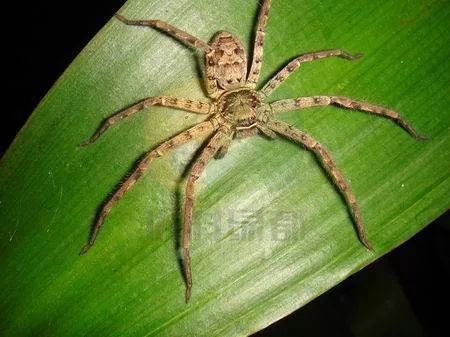
2. Use bacteria and insect control technology to kill pests, bacteria and fungi, etc. with natural microorganisms.
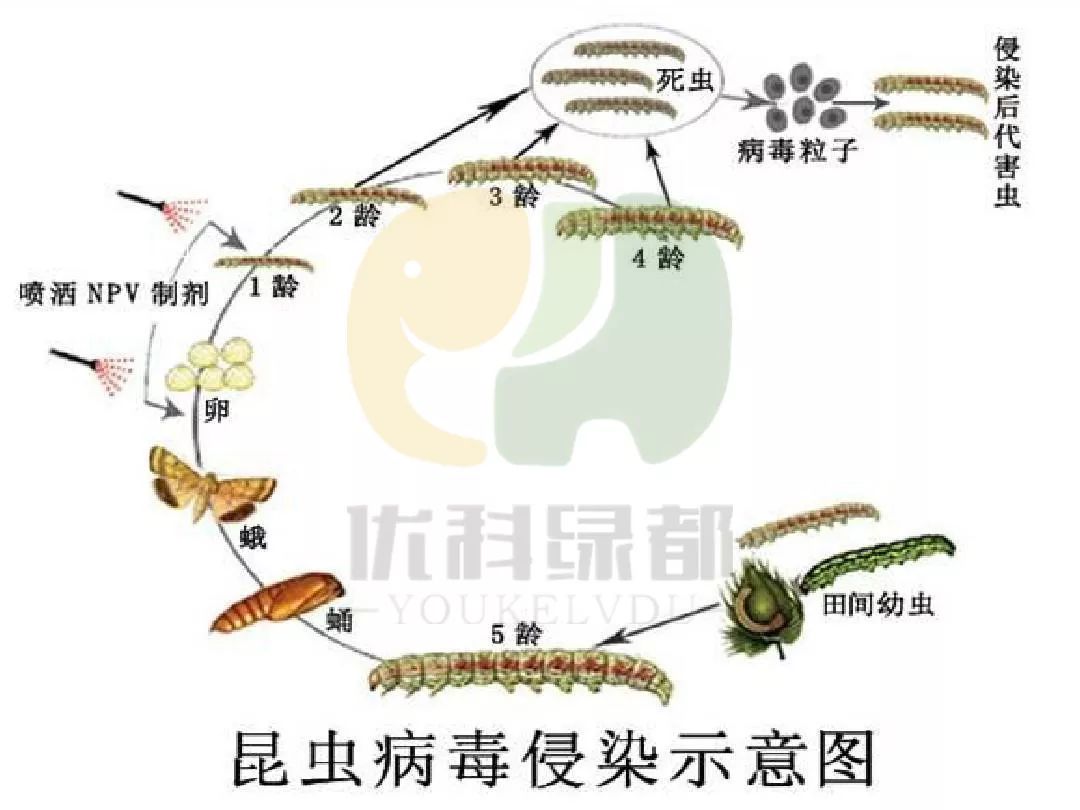
3. The bacteria treatment technology USES antibiotics produced by microorganisms in metabolism to eliminate bacteria.
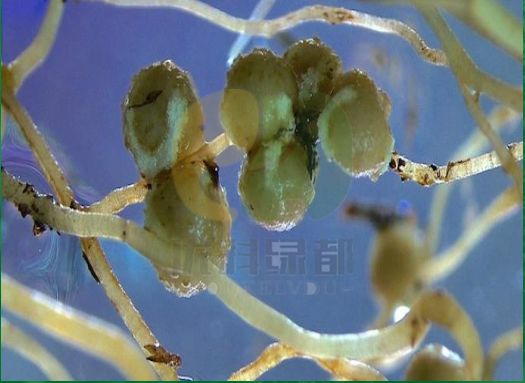
4, sex pheromone, pigment pest control technology, with the same kind of insect female hormone to kill the male insect pests and pigment killing.
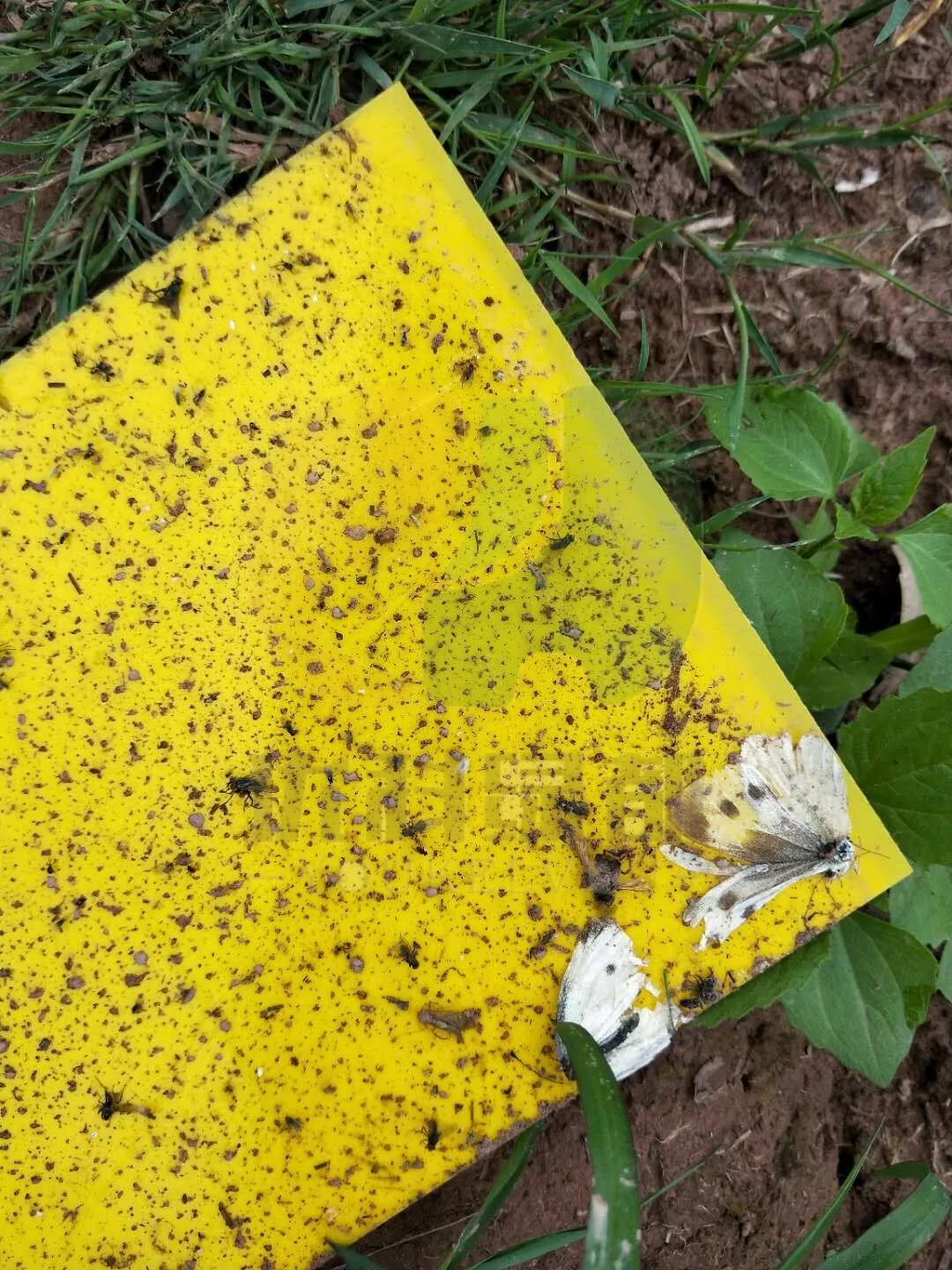
5. Transgenic insect-resistant and disease-resistant technologies: transgenic technologies are used to develop insect-resistant and disease-resistant varieties.
6. Use bacteria to control weeds, and use pathogenic microorganisms to control weeds, such as anthrax bacteria to control weeds in paddy fields.
7. Plant insecticidal and bactericidal technologies:
(1) photoactivator is the use of plant secondary substances in the light of the toxic effect of pests, viruses.
Inchetin is a kind of highly oxidized citric acid, which is separated from the active material, with insecticidal components.

Now, we will enter the field of biological control together with the world leader in biological control and biological pollination, Dutch company colbert, to focus on the professional, cooperate with nature, provide users with natural and safe nutrition solutions, improve crop health, enhance crop stress resistance, and finally achieve high yield and high quality.